| Celery TNAU Ooty - 1 |
Natural Farming |
Characteristics of celery :
- Ooty Horticultural Research Station maintained 6vatieties, from which this Ooty – 1 was choosen.
- This type of celery will grow by an average of 72.3 cm height. It is a short-term crop. The 115 days of age. It has a potential yield.The average yield of 30.5 t/ha.Grown in the Nilgiris district, 30.3 per cent more yield than the local type of offer. The seed yield of 1.40 t/ha. Smaller seeds. Color is brown.
- 1.71 percent of the oil present in the seeds. The seed oil is only 0.56 per cent of the local type. It has good fragrance so it used as spices material. Thelongitivity of leaves is higher.
- In mountainous areas, it can be kept upto 8 days, so it is optimized to carry to distant markets.
- The 100g leaves contain high level of protein content (1g), carbohydrate (3 g), sodium (88 mg), calcium (4 per cent) and iron (1 per cent).Leaves with dark green colour, excellent cooking quality.
- From this instant soup and instant spice powder, curry, Channa Masala and Vegetable curry can be prepared.This variety is resistant to leaf spot disease.
- It has root nematode, white fly and aphid insects resistant. It can be cultivated throughout the year. Nirpokam (February - April), karpokam (April – June) kadaipogam (August - October). It is cultivated all mountainous, which has a height of 900 meters above Mean Sea Level.
|
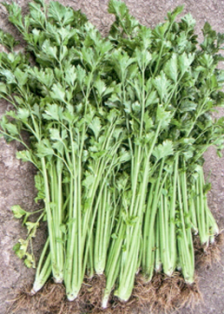 |
 |
Medicinal qualities :
- Celery’s young leaves and stem contain mineral vitamin and protein content, which is known as one of the important medicinal plants.
- The oil is made from celery has great fragrance. This aromatic oil helps the human brain to work effectively.
- It is the best medicine for rheumatoid arthritis such as under rheumatoid arthritis.
|
Nutrients in celery TNAU Ooty- 1 :
| Sl.No |
Description of the nutrients contained |
Celery TNAU Ooty -1 |
Local variety |
| 1. |
protein mg / 100 g |
1.0 |
0.8 |
| 2. |
carbohydrates mg / 100 g |
3.0 |
2.0 |
| 3. |
fatty mg / 100 g |
0.2 |
0.1 |
| 4. |
fiber mg / 100 g |
2.0 |
1.0 |
| 5. |
sugar mg / 100 g |
2.0 |
1.0 |
| 6. |
Sodium mg / 100 g |
88.0 |
65.0 |
| 7. |
Vitamin A (%) |
10.0 |
7.0 |
| 8. |
Vitamin C mg / 100 g |
6.0 |
4.0 |
| 9. |
Calcium (%) |
4.0 |
3.0 |
| 10. |
Iron (%) |
1.0 |
1.0 |
|
Cultivation techniques :
Soil and climate :
Good fertile well drained soil is very suitable for the crop. With high amounts of organic material rich in laterite soil pH of 6 to 6.5 is very suitable for the cultivation of the crop. If the soil pH is less than 4, may be applied of dolomite 2.5 t/ha to the soil 5 months before cultivation.
Season :
It can be cultivated in three seasons, i.e., Neerbogam (February - April), karbogam (April –June) and kadaipokam.
Breeding :
Celery bred by seeds. The seeds are very small, so mixed with ten times more sand and be sown in the nursery bed. |
Nursery :
Prepare the field to get a fine tilth.
Seed rate:
The seed rate is 1.25 kg of seed per hectare. To produce seedlings per hectare required a 100-square-foot nursery.1 m Width, 15 cm height and length required to set up the raised beds. The seeds are soaked ina 3% Panchagavyasolution, dry it in a shade and sow. While preparing the field, apply for one square meter 20kg farm yard manure, 5kg vermicompost, 10 kg bio compost manure, 200g Mycorhiza root internal fungus, 200 g Azospirillum and 200 g phosphobacteria can be applied.Take the weeds in the nursery and should be kept clean. Watering should be done once in two days. 3 weeks after planting the seeds will germination. After 75 days obtained good quality seedlings. |
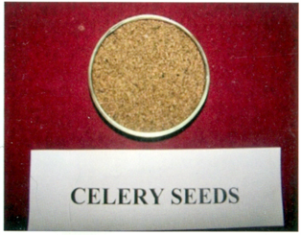 |
|
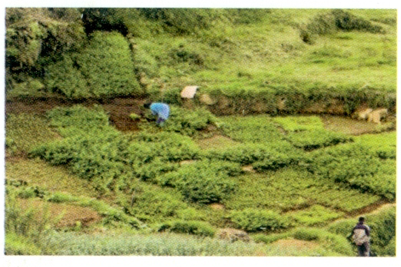
|
Land preparation :
Applied 30 t/ha of well decomposed farmyard manure. Along with farmyard manure, 5 ton bio compost manure, 5 ton VermiCompost, 10kg Metarizium, 10kg Azhosbirillum, 10kg phosphobacteria, 10 kg Mycorhiza root internal fungus, 1.25 tonnes neem cake, 2.5 kg Pseudomonas fluorescence and 2.5 kg Trichodermaviride can be applied. Plough the land well and then, 75 g composted cow manure, 1.5 kg cow dung herbal manure with 40 Litres of water mixed and spread as a large droplet to the ground and spray.
|
|
Planting:
Planting made during the rainy season. Good quality seedlings should be planting 4-5 cm row to row and 15 cm plant spacing.
Irrigation:
Proper and rapid irrigation for required for crop development. Need water once a week.
Post treatment:
The land must be maintained free from weeds. 4-5 times to remove the weeds for good growth of the crop. |
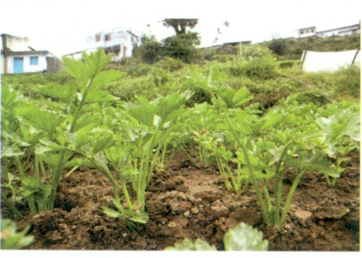
|
|
Crop growth regulators :
- Panchagavya 3% solution to be spray 4 times at intervals of 15 days.
- Pre harvest spray10% earthworm infusion 4 times at 15 days interval.
- Horn silicamanure 2.5g mixed with 50 liters of water spray 15 days before harvest.
- Spray bio-herbal manure 5 kg / ha mixed with 200 liters of water (45, 60 and 75 days).
- Pre-harvestapply 3%Dasakavya solution 4 times at 15 days interval as foliar spray.
- Spray 5% Manchurian tea extract 3 times in 15 days interval.
|
|
|
Crop Protection :
This variety is resistant to pests and fungal diseases.
Harvesting :
Celery preparing harvest in 115 days. The external thick stems are use to prepare soup, and internal stems are very young so used to prepare salad.
Yield :
Celery yield of 30.5 t/ha.
Celery TNAU Ooty - 1 based food products maker
Instant food products :
Machine of emerging fashion and lifestyle plays an important role in the immediate preparedness and food products.The people welcoming these types of food products. Adding celery in the fast food it reaches the nutrients to the people easily. So using drying technology, celery used to prepare food product as immediate use.
Celery can be used to made the following
Instant food products
Processed food products:
Homemade food products :
 |

|
The ingredients needed to prepare Celery Soup Mix:
Celery - 50 grams
Carat - 25 grams
Tomato - 25 g
Onion - 25 g
Cumin seeds - 10 gm
Pepper - 10 g
Cornflavour - 25 grams
Salt - to taste |
Celery Sambar powder Ingredients :
Celery seeds - 50 gm
Dry chilly - 50 grams
Coriander seeds - 100 gm
Mung dal - 50 gms
Chana dal - 50 gms
Bar - 10 grams
Pepper - 10 g
Cardamom - 10 grams
Cloves - 10 grams
Salt - to taste |
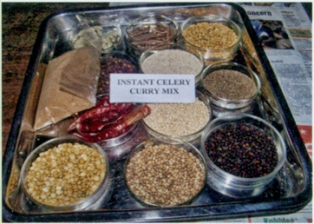 |
For more details
Professor and Head
Horticultural Research Station
vijayanagaram, Ooty - 643 001.
Phone - 0423-2442170
Email - hrsooty@tnau.ac.in |
|
|
|

